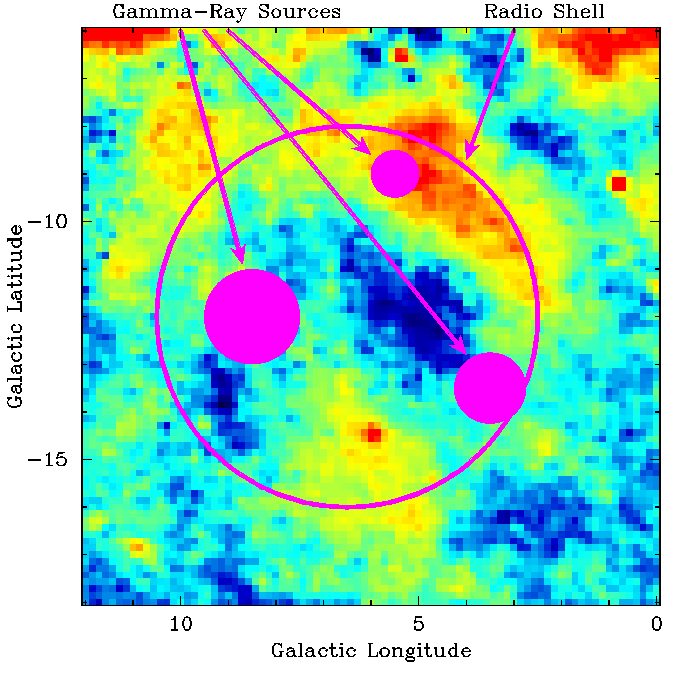

HartRAO Home > news > Cosmic Ray origins 1999/09/16
It was all in a day's work for a team of astronomers from Argentina and South Africa. First, discover a new supernova with a radio telescope. Next, tag two previously unidentified gamma-ray sources with the Compton Gamma Ray Observatory. Then, tie them all together to provide the first observational evidence of the leading cosmic-ray origin theory.
The results of this hat trick of observations are presented today at the 5th Compton Symposium, an international meeting of gamma-ray experts held this year from September 15-17 in Portsmouth, N.H. The meeting is hosted by the University of New Hampshire and NASA Goddard Space Flight Center. The scientists behind the observations are Drs. Jorge A. Combi, Gustavo E. Romero and P. Benaglia of Instituto Argentino de Radioastronomia; and Dr. Justin L. Jonas of Rhodes University in South Africa.
The origin of cosmic rays remains a long-standing mystery in contemporary astrophysics. Scientists suspect that cosmic rays -- essentially atomic particles that bombard the earth at nearly light speed -- are hurled through space to such great speeds by the shock waves of exploding stars, called supernovae.
Earlier observations have shown supernovae to produce cosmic ray electrons. Today's results, however, provide the first observational evidence of supernovae producing cosmic ray protons, which are a hundred times more common and a much heavier form of cosmic ray.
"Most of cosmic rays that reach the Earth are protons, not electrons," said Dr. Combi. "Are these protons also accelerated in supernova remnants? The evidence has been elusive up to now."
The first step in addressing this cosmic mystery was finding the undiscovered supernova remnant. A supernova remnant is the hot gaseous remains of a star explosion. Using the Hartbeesthoek radio telescope in Krugersdorp, South Africa, the astronomers spotted the yet-unnamed remnant within our Galaxy about 1,600 light years from Earth. The remnant, produced from a supernova explosion 15,000 years ago, is large yet weak, according to Dr. Combi. Its faint radio waves were buried in the background radio emission from the Milky Way and thus went unnoticed until now. The technique used to "remove" the diffuse radiation that veiled the supernova remnant is a feat in its own right.
The astronomers next noticed that the position of the supernova remnant was close to two -- and maybe three -- unidentified gamma-ray sources in the Third EGRET Catalog, issued earlier this year. EGRET is one of four instruments aboard the Compton Gamma Ray Observatory and was built at NASA Goddard. The type of gamma-ray radiation that the astronomers observed with EGRET could only be produced by protons colliding with other protons. This collision produces a short-lived sub-atomic particle called a (neutral) pion and a subsequent burst of energy in the form of two gamma-ray photons.
"We think that the gamma-rays are produced when the protons locally accelerated in the supernova remnant collide with cloud atoms producing copious pions, which decay and yield [gamma-ray] photons in the EGRET energy range," said Dr. Romero.
In other words, the astronomers suggest that protons floating in the interstellar medium were accelerated to high speeds by the supernova shock. These protons collided with other protons in a nearby atomic cloud of hydrogen gas and produced the observed gamma rays.
Such a situation was theoretically predicted some years ago by Felix Aharonian at the Max Planck Institute for Extraterrestrial Physics, as well as by other scientists. The simultaneous detection of a supernova remnant, atomic clouds and EGRET sources has remained evasive until now.
According to Romero, the newly discovered supernova "will surely constitute an outstanding natural laboratory for testing our ideas on the origin of cosmic rays in the years to come. Since we can determine the spectral shape of both the electron and proton cosmic rays in the source, we can now compare the relative efficiency of the acceleration mechanism and infer physical conditions in the supernova remnant."
Drs. Combi and Romero will be in Portsmouth to present their results. The Compton Symposium is the fifth in a series of international symposia dedicated to research in gamma-ray astronomy with an emphasis on results from CGRO.

This is an image of the radio emission from the region of sky near the cluster of three previously unexplained gamma-ray sources. The data for this radio image was extracted from the recently-published Rhodes/HartRAO 2326 MHz survey of the southern sky. Image processing techniques had to be applied to the data to enhance the details in the image. The radio intensity is coded by colour with red indicating the more intense emission. The estimated position of the radio shell of the supernova remnant (SNR) is indicated by the circle, and the purple spots specify the positions of the gamma-ray sources.
Contact:
Dr Justin Jonas
Physics Dept
Rhodes University
Grahamstown
email: phjj@hippo.ru.ac.za
phone (+27)46 603-8452